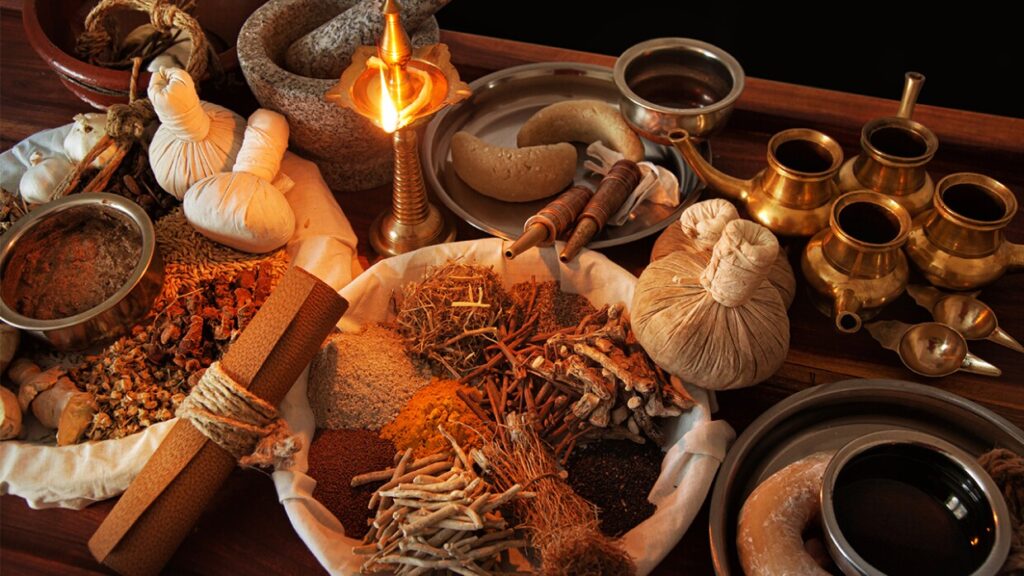Introduction: A 5,000-Year-Old Science in a 21st-Century World
In the current world where we are experiencing massive technological developments and the emergence of synthetic medicines, Ayurveda, the age-old holistic medical system of India, is, oddly, making a revival. The ancient science has once again gained attention, with a turmeric latte on a New York café menu, and Ayurvedic skincare regimes trending on TikTok. Is this revival based in real science, or does it have cultural nostalgia and belief fueling it?
When we analyze Ayurveda in terms of contemporary medicine and the global health and wellness leading practices, one key question poses itself: Is Ayurveda a feasible medical system in the 21st century, or is it merely a belief?

What Is Ayurveda? A Brief Recap of Ancient Wisdom
Ayurveda refers, literally, to the science of life, a translation of Sanskrit compound ayur, (life), and Greek word Veda ((knowledge)). It has existed on the Indian subcontinent since more than 5,000 years ago and is thought to be the oldest system of medicine in the world. In essence, Ayurveda is used to find balance between the body, the mind and the environment by utilizing:
- Eating habits and lifestyles
- Medicines made of herbs and mineral substances
- Panchakarma (detoxification therapies)
- Meditation and yoga
- The philosophy of three doshas (Vata, Pitta, Kapha body constitutions)
In contrast to the modern medicine which, as it is sometimes known, treats symptoms but not the cause, Ayurveda seeks to pinpoint the leading cause of improper balance, rectify it.

Fact: Global Recognition and Integrative Medicine Ayurveda’s Global Reach
Ayurveda’s Global Reach
Ayurveda is no longer an Indian heritage, today Ayurveda is a worldwide wellness trend. In terms of global ayurvedic market, it is projected that the industry will grow to USD 18.7 billion in 2027, translating into 15.4 percent CAGR. The Ayurvedic clinics, products, and retreats have increased significantly in countries such as Germany, the USA, Japan and even Brazil.

Ayurveda and WHO
In 2022, the World Health Organization (WHO) opened the Global Center of Traditional Medicine (GCTM) in Jamnagar, Gujarat, in partnership with the Government of India. This is a historical recognition for Ayurveda in being one of the major constituents of the world health systems.
According to Dr. Tedros Adhanom Ghebreyesus, WHO Director-General, astoundingly, the number of people who have cardiovascular diseases (CVD) has reached one billion.
“There is a long history of use of traditional medicine including Ayurveda, which is part of the health systems around the globe. It is worth a respectful scientific study.”
Faith: Where the Lines Blur
Although one could not dismiss the popularity of Ayurveda, the question that may arise is how much of it is supported by the modern day scientific criticism?
Scientific Appraisal: An ongoing activity
RCTs, publishable and reproducible data, and peer review have become essential to modern clinical trials and evidence-based medicine. Although certain Ayurvedic herbs such as Ashwagandha (Withania somnifera), Turmeric (Curcuma longa) and Triphala have indicated a benefit in laboratory and small clinical trials, many Ayurvedic compounds remain unregulated under international medical codes.
For instance:
In a 2021 meta-analysis in the Journal of Alternative and Complementary Medicine noted that there was moderate evidence supporting the adaptogenic nature of Ashwagandha.
A 2023 paper published in Frontiers in pharmacology mentioned the anti-cancer and anti-inflammatory effects of curcumin but highlighted the low bioavailability of the compound as a drawback in clinical use.
Standardisation and Quality Control
One of the issues is inconsistency in Ayurvedic preparations. The particular herb in a certain batch may be infinitely more potent than some other batch, depending on:
- Soil quality and region
- Harvesting season
- Preparation method
Makes standardization (an essential tool of modern pharmacology) almost unachievable, or near impossible, according to the classical procedures.
Where Ayurveda Excels: Preventive and Lifestyle Medicine
Nevertheless, Ayurveda has its lasting strengths, particularly in the points where conventional medicine is usually lacking.
1. Holistic Approach
Ayurveda does not treat people based on individual symptoms. The way of life, nutrition, emotional, and sleep life is all perceived to be a part of healing. This is more and more in line with the modern trend of integrative medicine.
2 Focus on Prevention.
Ayurveda embraces the active approach to health through the routines that have been adopted including Dinacharya ( demonstrated through daily routine) and Ritucharya ( specified in seasonal adaptation).
The routines adopted in Ayurveda such as Dinacharya (the daily routine) and Ritucharya (seasonal adaptation) promote an active approach to health. These rituals focus on aligning with the rhythm of night and day, detoxification, and a clear mind long before the disease appears.
3. Mind-Body Connection
As long as neuroscience lagged behind, Ayurveda considered that the state of mind and emotional factors have a direct influence on physical well-being. This has become a widely-accepted assumption in the field of psychoneuroimmunology-a new science that
investigates the communication process between the psychological system and the nervous system and immune system.

The Case of Chronic Diseases: Ayurveda’s Quiet Victory?
Modern day medicine is obviously working in acute care cases, surgeries and infections, as well as in critical cases. However, in the case of lifestyle diseases, which include:
- Diabetes
- Hypertension
- IBS and stomach illnesses
- PCOD/PCOS
- Stress and anxiety
Ayurveda presents means of managing long-term, sustainable.
In a comparative study done in Kerala in 2022 on 500 Type 2 diabetic patients, it was seen that the patients using integrative Ayurvedic protocols had a 17 percentage lower drop in HbA1c levels over 6 months than patients with standardized care only plus allopathic treatment.
This points to possibility and not substitution- Ayurveda and allopathy, they can work compatibly
The Pitfalls: Misuse, Misbranding, and Myth
1. Unregulated Commercialization
The pseudoscience of pseudo-Ayurvedic products has been the result in the growing wellness market. Brands often label products “Ayurvedic” to capitalize on the trend, without adhering to classical formulations or sourcing standards.
2. Heavy Metal Pollution
According to a Harvard study (2019), close to one in five Ayurvedic supplements sold online in the U.S. contained dangerously high levels of lead, mercury, or arsenic, usually the result of careless traditional preparations (such as Rasa Shastra (use of purified metals)) or lax controls during manufacturing.
3. Gurus Vs Science
Misinformation on a celebrity basis also grows considerably as well, with charisma taking the place of competency. When Ayurveda is utilised as a mode of pseudo-science, unsubstantiated magical treatment or anti-modern lunacy, then Ayurveda loses its credit.
Bridging the Gap: India’s Push for Integrative Health Systems
The government of India has made attempts to re-country-ize and normalize Ayurveda:
- The Ministry of AYUSH (Ayurveda, Yoga, and Naturopathy, Unani, Siddha and Homeopathy) acts since 2014 to support evidence-based research.
- All India Institute of Ayurveda (AIIA) has integrated clinical trials with AIIMS, ICMR at Delhi.
- Since then, several Ayurvedic hospitals have been accredited by the National Accreditation Board for hospitals (NABH), that has increased standardization and accountability.
Can Ayurveda Be Scientific? Yes—If We Let It Evolve
To emerge as a valid healthcare option in the 21st century, Ayurveda should:
It was put under harsh clinical trials
- Standardized and recorded in a digital fashion
- Lectured in colleges of medicine along with evidence-based research
- Unburden by dogmatic adherence either by custom or loyal remorse to some Governor General character to whom to appeal invisible etc.
India with her rich legacy of traditional knowledge systems can play a leading role in integrating AI, big data, genomics to find out how Ayurveda can be used to contribute to personalised and preventive medicine of the future.
Faith Strengthened by Fact
And thus, is Ayurveda science or superstition? The solution does not consist in opposing one to the other, but, on the contrary, in finding a bridge between them. Belief in ancestral knowledge does not always equal unscientific beliefs as long as it is subject to debate, study and change.
In a time when health systems worldwide are struggling with burnout, antibiotic resistance, and chronic disease, Ayurveda’s call for balance, self-awareness, and prevention feels more relevant than ever. Ayurveda is either fact or faith and when appropriately approached it may just be the guide to assist the health care industry find its own center once more.










